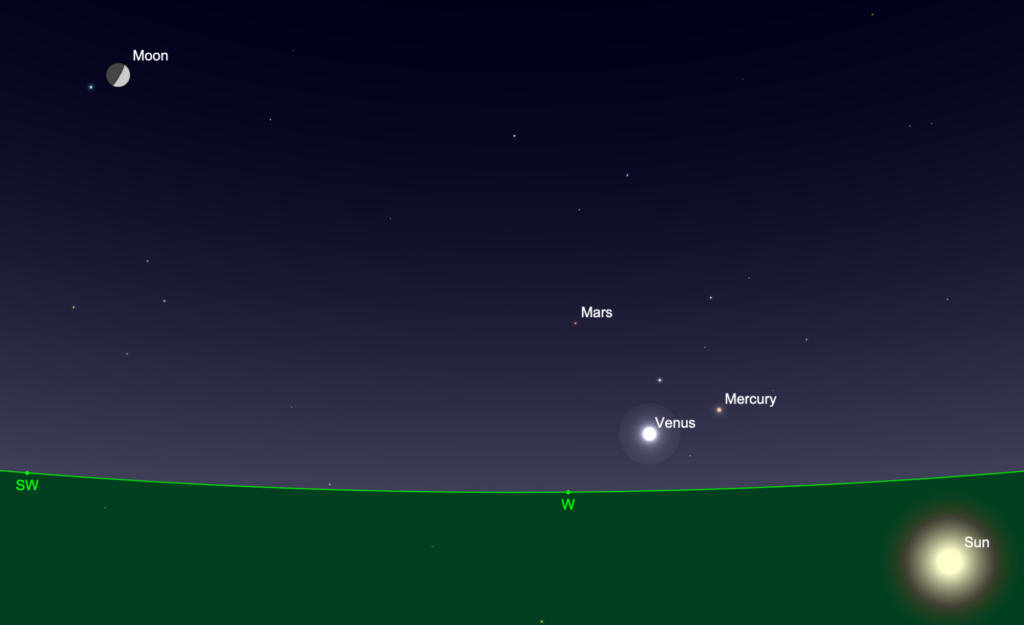Sky Report: July 24 – 30

The western sky on Monday, July 24th, 35 minutes after sunset. The star Regulus is above Venus and the star Spica is near the moon. Mercury has moved next to Regulus on Friday the 28th. Graphic created with SkySafariAstronomy.com.
Say good-by to Mars, Venus, and Mercury in the evening sky. Mars and Venus have been in the evening sky all this year and before, while Mercury is finishing a brief appearance. You may see them the first day or two of this week but only if you have a low western horizon and the air is free from haze and dust. Even then you’ll want binoculars, which every stargazer must have (you can acquire an adequate pair for $50 or less). If you’re up for the challenge, look on the 24th about 35 minutes after sunset when Venus and Mercury have an altitude of only about 5°. They’re 6° apart, so find Venus and then Mercury. Mercury is quite bright so seeing it is feasible although it won’t be easy.
Much harder – and here you’ll definitely need binoculars – are Mars and the star Regulus, which are similar in brightness, or should I say “faintness”. Consult the chart. Wide-angle binoculars may show Venus, Mercury, and Regulus at the same time, while Mars is too high to fit in the field-of-view. Again, this will be a challenge.
Mars is on the far side of the sun, and like the stars beyond it Mars sets 4 minutes earlier each night, due to the earth’s orbital motion around the sun, so we’ll gradually lose Mars early in August.
Venus is moving between the earth and sun and it sets 6 minutes earlier each night, so we’ll lose it this week. Notice how quickly it loses altitude and disappears. The evening sky won’t be the same without it!
Mercury’s motion is more complicated. Mercury is swinging around from behind the sun toward us and is headed to its “greatest eastern elongation” before moving between us and the sun, so it’ll be around – but low – for most of the next two weeks. A curiosity that continues the challenge is to see the star Regulus a scant ¼° to the right of Mercury on the evening of Friday the 28th; they’re separated by half the diameter of the moon so you can see both together in medium-high power in a telescope. Regulus is 1/4th as bright as Mercury.
So seeing these planets will be a challenge on the 24th — but not a challenge that night will be seeing the star Spica – the brightest star in Virgo – 2° from the nearly first-quarter moon.
Saturn rises later, and you’ll first see it a bit south of due east at roughly 10 p.m., depending on where you are within your time zone, and Jupiter follows 3 hours after Saturn. Saturn rises 12 minutes before Mars sets, so theoretically there is no moment when no planet is visible. Although Saturn is universally admired as the prettiest planet as seen through a telescope, on account of its rings, you want to wait to look at it for at least an hour, and preferably 2 hours, later so it clears the most turbulent layers of our atmosphere.
Stellar Vista Observatory provides portable telescopes and tripod mounted binocular kits on loan for free to residents and visitors in Kane County. Enhance your enjoyment of the night sky! To learn more, request a loan, or attend one of SVO’s free public star parties for 2023, visit https://stellarvistaobservatory.org/ or drop in to the Kane County Office of Tourism.






Comments are closed.